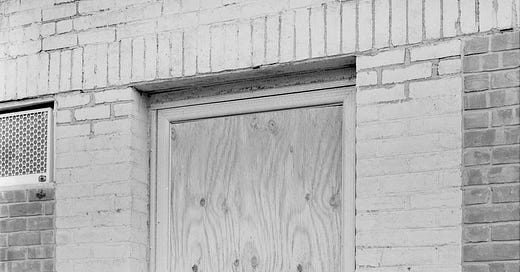Ways to Say Goodbye
This short-form piece was written for the final issue of Chosen Family, a Hudson Valley zine and show flyer.
At some point almost two years ago, I started a project called Ways to Say Goodbye. It’s a collection of photographs made mostly within the span of a year, with the exception of one image I took in 2015 (to which I can’t seem to say goodbye). Allegedly it is an “ongoing” project, though I haven’t added a single photograph since last summer, and my camera has carried the same roll of film for almost a year. For context, I use a camera that nets 8 frames per roll, which should give you an idea about how few pictures I’ve made in the last handful of months. The project has little to do with saying goodbye, if anything at all, and so I don’t really know why I landed on this title. I guess we could consider taking a photograph as a way of saying goodbye (to a moment in time), but that seems far too entangled in a relationship to images that I’d like to steer clear from.
I think that at the time I was working on the project, I was simply interested in the ways that people say goodbye to you; and subsequently, the variety of ways you say goodbye to others. There doesn’t seem to be an agreed-upon code with the goodbye, or at least not one that I can see. For example: when is it appropriate to hug a person goodbye? I have friends of years that I leave with a small part and wave, while countless times I’ve given a hug goodbye to someone I only met earlier that day (and probably greeted with a handshake at most).
The birth of a goodbye is typically motivated by the frequency of a conversation. Often the goodbye occurs on opposite ends of the spectrum: awkward silence (low-note) or uproarious laughter (high-note). Extremes seem to mark convenient transitions. In the Seinfeld episode “The Burning,” George Costanza uses the convenient transition of the high-note to leave office meetings early. There is probably an episode that has a good example of a low-note goodbye, but to be honest I wasn’t expecting to bring up Seinfeld, so we will move on.
Some goodbyes are associated with groups of people. The Irish Goodbye is when someone leaves without saying goodbye. The Jewish Goodbye is a protracted goodbye in which one finds themself departing maybe thirty minutes after they said they were leaving. My wife is Jewish and I am Irish, yet she prefers an Irish Goodbye and I’m often leaving hours after I anticipated – let’s call it a cultural exchange.
Most goodbyes come with an addendum: see you soon, let’s do this again, don’t be a stranger, etc. Goodbyes are rarely a stop, but more often a pause. Perhaps this is part of why grief can be so devastating: we are not used to saying goodbye without that addendum. It’s a phrase that rarely occasions a permanent separation, and so to some degree we might feel a desperate hope that there is a chance we will see them soon (pause) after they’ve left (stop). Maybe we need to expand the ways in which we pause seeing one another.
It looks like Chosen Family is saying goodbye. I’m sure like many readers, I hope this goodbye is followed with a “see you soon.” And if not, at least the zine has provided a model for something that could exist. It’s been a wonderful twenty three issues.




